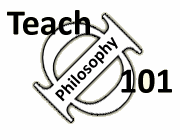Teach Philosophy 101
Free resources for
philosophy teachers!
"One of the most comprehensive, well-researched, and accessible guides for teachers that I have ever seen." James Lang, Chronicle of Higher Education (read full review of TΦ101)
Teaching With Technology
Some interesting technology applications. Please send additional ideas.
-
Clickers. Especially in large lecture classes, some professors now use student response systems or clickers to stimulate class participation, we discuss this in detail in our lectures and discussion area. Students buy the clickers when they buy their textbook and use them to respond to questions posed by the instructor. The results appear in a bar graph in the front of the room (so your class will resemble the quiz show "Who wants to be a millionaire?"). Instructors use them for feedback, and to stimulate discussion. TΦ101 has had enormous success with these little devices in creating a high level of student engagement and participation in large lecture classes. Their effectiveness in a new technique called "Peer Instruction" has been documented in some impressive evaluation studies.
-
iPad apps. Not surprisingly, there are some useful apps for the iPad and iPhone. There are several programs for taking attendance (just search for "attendance" in iTunes. TΦ101 also likes to have students submit papers as pdf files, which can then be easily graded on a program such as iAnnotate.
-
Anonymous Grading Apps. Many of the Learning Management Systems made available by our institutions (i.e., Blackboard, Canvas) have applications to facilitate author-anonymous grading. Students upload their papers, and the LMS both hides the author name and randomizes the order in which the papers are presented to you when grading. Check your LMS, or with your local IT support, to find out what is available. For a discussion of the value of anonymous grading, see this Daily Nous thread.
-
Video feedback on papers: Tanya Hall, Dean Tracy, and Andy Lamey (UC, San Diego) experimented with giving students feedback on their papers for an entire semester using 5-minute videos recorded via Photobooth (an OS X application for Mac), which they uploaded to Blackboard for students to view. Hall, Tracy, and Lamey found that students perceived this feedback as clearer, and more constructive/useful than written feedback, and also that they perceived the professor or TA giving the feedback as more empathetic. As a result, students were more motivated to use this feedback to productively inform their future work in the course. Video feedback also seems to carry the added benefit of reducing the time it takes to offer detailed comments on student papers.
-
Grade Calculator. This helpful grade-calculator, designed by Daniel Immerwahr, can be used by both students (to figure out how they would need to do on the next test to improve their grade) and by faculty members to calculate either individual grades or grades for a whole class. It also allows faculty members to create rosters for large and small classes. For a full grading and attendance manager, check out GradeKeeper, a commercial program available for a small yearly fee.
-
MindMap Software. There are a number of free and commercial mind-mapping software programs available. Some faculty members ask students to use these in developing their papers. But they can even be used for lectures (instead of powerpoint), or as a way to record the points that students are making in discussions. You can find an overview of available software here.
-
Wikis. Given today's emphasis on collaboration in the workplace, assigning students to do projects outside of class is as important as it is challenging. A technological solution is to set up a "wiki" that allows a defined group of students to collaborate on a document. (Wikipedia is the most famous example, where anyone in the world can edit any entry). Nancy Hancock, from Northern Kentucky University (and a former President of the American Association of Philosophy Teachers) has a handy guide to getting started.
-
Perusall. A social annotation platform designed by teachers and researchers at Harvard. It is free software designed to allow students to read and collaboratively comment on the same text. It was designed to increase student engagement with the text. Here is a study from the developers of Perusall. You can participate in a demo here. TΦ101 has not yet had a chance to try it out with students, but will report back soon!
-
Online Forums. Our students respond well to technology, and are used to communicating through Facebook, text messaging and IM. Many professors are now starting to use on-line forums as a way to enhance class discussion. For a terrific introduction and lots of good ideas, consult Christopher Panza, Adam Potthast, and Christie Cathey, "Thinking Outside the Room: Enhancing Philosophy Courses with Online Forums." Teaching Philosophy 29:4 (2006), 279 ff.
-
Argument mapping software. Rationale is a computer based argument-mapping program that helps students organize their arguments in learning critical thinking and in preparing papers or presentations. It was developed by an Australian logic professor, Tim van Gelder. The homepage for Rationale has some useful instructional materials on how the program can be used.
-
Second Life. This popular program has many features that can be used to teach philosophy courses, including the ability to create remarkable on-line chat rooms (where the students create avatars that can meet and either speak or exchange text messages). The March 2011 issue of Teaching Philosophy has two articles on promising efforts to integrate this software into intro classes.
Author: John Immerwahr
Update: 26 June 2016 (E. Tarver); January 2020
